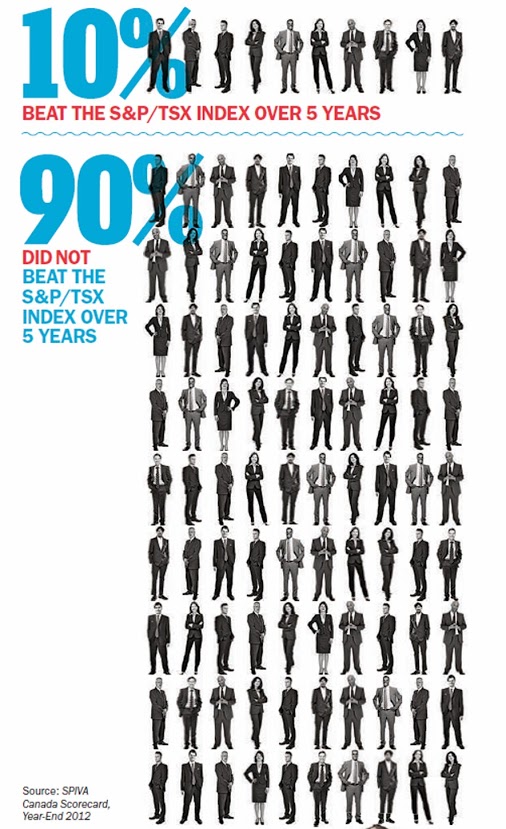In highschool, Emily’s economics class played a game where each student was given an imaginary sum of money to invest in a virtual stock market stimulation. The purpose of the game was to teach the students about investing and money management through trading stocks. The student with the largest equity in their portfolio at the end of the game was pronounced the winner. Most of the class chose their investment portfolios at random and hoped for the best. In the end, the winner appeared to have won through luck and did not display a higher aptitude in investing than the other students. Through playing the game, Emily came to associate stock trading with investing.
It was only later that she learned that there are two approaches to investing: active and passive. The first step to investing is to decide on which rabbit hole to go down. Active investing offers the possibility beat the market with the opportunity to limit losses. Passive investing offers the probability of higher market returns over the long term. While the prospect of the above-market returns potentially achieved through active management is tempting- it would mean reaching our financial goals earlier- there are four reasons as to why I’ve decided not to pursue active investing.
1. Lack of Time
Active investing requires a significant time commitment to research and analyze market trends and company financial performances; for some, it’s a full time job. Understanding and applying the information is a whole other ball game, requiring even more time and energy. I’m not interested burying myself in stacks of financial statements or checking stock prices multiple times a day to buy low and sell high; I’d rather devote my time to my family, friends and hobbies.
2. Small Chance of Success
Since I am not willing to dedicate the time and energy to learn to effectively pick my own stocks, I would need to rely on someone more knowledgeable and equipped. Enter the professionals: fund managers. Let’s take a look at for a track record of fund managers’ performance and how often they actually beat the market index.
The S&P Indicies Versus Active (SPIVA) compares the performance of actively managed funds against relevant index benchmarks. According to the 2012 year end report, in a 3 year time period, only 15% of actively managed funds beat their respective benchmarks. Over a 5 year period, the percentage of actively managed funds that beat the benchmarks dropped to 10%. I only have a 10% chance of choosing a fund manager who can beat the beat the market over the long term.

Infographic courtesy of Moneysense Magazine
3. Can’t Predict the Future
Everywhere you turn, investors are constantly warned that past performance is not a guarantee of future results; that simply translates to the following: there no promises when it comes to actual returns. Think of forecasting market trends as predicting the weather; regardless of the meteorologist’s educated guess, you may be caught in the rain without an umbrella. At its peak, Blackberry (formerly known as RIM) traded at $149.90 per share. Currently, Blackberry is trading at $9.56. No one could have fully predicted a loss of almost 94%, even with all of the negative media attention.
4. The Fees
Active investing may cost more money that could otherwise be used for investing. Individually assembled portfolios or mutual funds are subject to higher fees. The average mutual fund fee in Canada is 2% of the total amount invested each year. By comparison, the average fee of the passive Global Couch Potato TD eSeries portfolio is 0.44%. For example, lets say an index earns 10% in returns for the year. If a fund costs 2% a year in fees, that is only an 8% return on investment; a fund manager must earn 12% return on investment to match the returns of the index.
The Last Word
My decision not to invest actively was determined by a few different things. First, I don’t have the time or bandwidth to analyze and understand the latest market trends. With a full-time job and an attention-needing toddler, free time is limited; I’d prefer to spend my spare time playing soccer. Active investing involves a gamble. Without the ability to predict the future or the guarantee of selecting a fund manager that would outperform the market, the odds seem to be stacked in the favour of a losing gambit. An active approach to investing can also be very costly. The fees would inevitably erode the potential gains. As a result of these considerations, I’ve chosen to invest with a passive approach.
Active investing in the real world with real money isn’t much different than playing a pretend stock picking game with imaginary money. Like the game, real world successes in active investing require a lot of knowledge and luck- both of which I don’t have.
Do you have a good reason to invest in individual stocks?





I definitely don’t have any desire to be a passive investor. I think Ramit Sethi has it right when he says for most of us who don’t have the time and inclination to dig deep into this stuff, it’s not worth it – use index funds and leave well alone.
True story. Spread the good word!